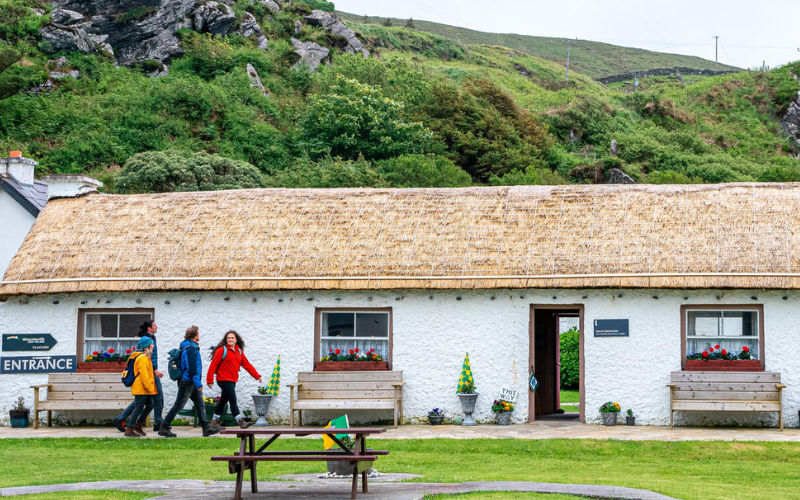Around 25,000 new historical records have been made available to the public to mark the 102nd anniversary of the destruction of Ireland's Public Record Office during the early days of the Civil War.
Highlights of the new digital collection include a precious 15th-century register from Co Armagh and "The 1798 Collection," providing digital access to more than 8,000 items in the Rebellion Collection, providing an insight into one of the most pivotal uprisings in Irish history.
The records have been made available at the Virtual Record Treasury of Ireland (VRTI), a digital recreation of the Public Record Office launched in 2022.
Medieval Exchequer records, digitized and translated up to 1327, are also included in the new digital collection. The records, digitized by the National Archives UK, provide details from pivotal years leading up to the Scottish invasion of Ireland under King Robert Bruce.
A small sample of the transcripts from the pre-Famine census is also available to view online for the first time.
A volume from the huge State Papers Ireland collection has also been made available at the Virtual Record Treasuring, providing a view from London in the 1600s.
Anniversary Release! #OTD 102 years ago the Public Record Office of Ireland was destroyed - but the recovery work continues.
— Virtual Record Treasury of Ireland (@VirtualTreasury) June 30, 2024
See all our new record releases for 2024 at https://t.co/p2WOj5gy6f ... and wait until you see what we are preparing for 2025! ? pic.twitter.com/fzx627XRG9
Work is underway to uncover the transcripts of the census, which were destroyed in 1922. To date, the Virtual Record Treasury of Ireland has identified around 200,000 names from the lost pre-Famine census.
The new collections have been curated and digitized in collaboration with National Archives Ireland, National Archives UK, and the Public Record Office of Northern Ireland.
Meanwhile, the Virtual Record Treasury has also been upgraded to mark the 102nd anniversary of the destruction of the Four Courts during the Civil War, including the introduction of enhanced navigation and discovery.
More than 100 million words of transcribed text have also been added, while our full-scale recreations of entire series of archives known as Gold Seams, and ten Curated Collections, are now also available.
Trinity College historian Peter Crooks, Academic Director of the Virtual Record Treasury of Ireland, said the new additions to the Virtual Record Treasury shine a light on more than seven centuries of Irish history.
"Since the Virtual Treasury was first launched in 2022 on the centenary of the Four Courts fire, our collections, curated with the help of partners across Ireland, Britain, and the USA, have doubled in scale. But this is only the beginning," Crooks said in a statement.
"We are continuously advancing technology and forging new partnerships to establish Ireland as a global leader in the creative exploration of digital archives.
"This year’s releases illuminate seven centuries of Irish history, reaching back to the Middle Ages and stretching across the island, from 1821 census returns for Inishowen, Co Donegal, to letters concerning the aftermath of the battle of Vinegar Hill, Co Wexford, during the 1798 rebellion."

A very early example of paper replacing parchment in Ireland, Archbishop Swayne's register dates from the mid-1400s.
Catherine Martin, Ireland's Minister for Tourism, Culture, Arts, Gaeltacht, Sport, and Media, welcomed the addition of the new collections.
"The Virtual Record Treasury of Ireland is a meaningful and important legacy of our Decade of Centenaries," Martin said in a statement. "It is wonderful to see what has been achieved - These archival sources will be of great interest to many different audiences, at home and abroad, who want to learn more about the story of our past.
"I welcome the research on the pre-Famine census records – which will give us a richer understanding of the lasting legacy of one of the most tragic and transformative events in our history.
"I am also delighted that in the past year, the Virtual Record Treasury has brought its work to audiences in Donegal, Mayo, and Wicklow, directly connecting with communities whose deep histories are being made newly accessible."
* All images courtesy of National Archives, UK; National Archives, Ireland and PRONI.
![Virtual Record Treasury of Ireland: List of evidence compiled against Lord Edward Fitzgerald....[Sunday, 30 September 1798]. The Rebellion Papers shine a unique light on the security apparatus of Dublin Castle during the 1798 Rebellion.](https://www.irishcentral.com/uploads/article-v2/2024/7/164055/cropped_MI_1_Ireland_s_Virtual_Record_Treasury_.jpg?t=1719913362)



Comments